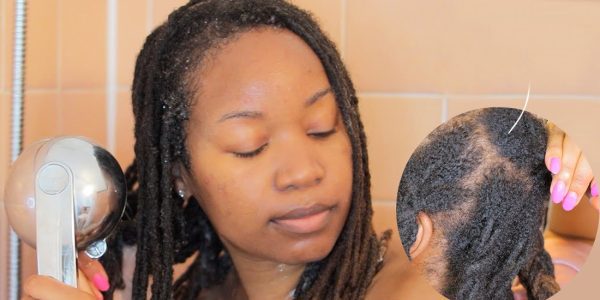
Dreadlocks need special care to stay healthy and vibrant. It might seem hard to wash your dreads, but if you stick to a pattern, you can keep them clean and healthy. The information in this guide will teach you how to wash your dreadlocks so that they feel clean and new again.
When To Wash Dreadlocks Hair
Dreadlocks, unlike straight hair, trap dirt, sweat, and product buildup at their base. Excessive accumulation can cause scalp itching, congestion, and loss of shine. The frequency of washing depends on factors like hair type, activity level, and product usage. Oilier scalps may need more frequent washing, while sweating during exercise or living in humid climates may require more frequent washing. Using styling products can also lead to faster buildup, requiring more cleansing.
A general washing guideline is to wash dreadlocks once every 1-2 weeks, allowing for regular cleansing without stripping away natural oils or causing excessive drying. Other signs to watch out for include visible dirt or debris, unpleasant odors, and loose hair near the roots. These signs indicate the need for regular cleansing and prevent the buildup from stripping away natural oils.
How To Wash Dreadlocks Hair
The following guide will help dreadlocks lovers get the best idea on how to wash their dreadlocks.
Gathering Equipment For Washing Dreadlocks
It is important to bring close all equipment used for washing your dreadlocks. They include:
- Gentle Dreadlock Shampoo: Stay away from harsh soaps that take away your hair’s natural oils. For dreadlocks, look for a solution that clarifies or doesn’t leave behind any residue.
- Conditioner (Optional): Some people like to add wetness to their dreadlocks with a lightweight conditioner that is made just for them.
- Detangling Tool (Optional): A crochet hook or dreadlock comb can help free any knots that have formed near the roots. Be careful not to untangle your dreads when you use it!
- Towel or dreadlock drying rack: Dry towels may be too rough for curls. Choose a microfiber towel or a drying rack that is made just for dreadlocks.
Prepping The Locs
To access your scalp, gently separate your dreadlocks at the roots using your fingers. If buildup is present near the roots, use a detangling tool to loosen debris, being gentle to avoid unraveling your dreads.
Washing The Locs
To clean dreadlocks, wet them completely with warm water. Apply a small amount of shampoo to your scalp, massaging it in to loosen dirt and oil buildup. Avoid scrubbing the dreads, as this can cause frizz. Work your way down the suds, allowing them to gently cleanse. Rinse thoroughly with clean water, repeating if necessary, to remove all shampoo residue.
Conditioning
Apply conditioner to mid-lengths and ends of dreads, avoiding roots. Leave it on for a few minutes for extra moisture. Rinse thoroughly with clean water to remove conditioner residue.
Drying
To maintain dreadlocks, gently squeeze out excess water using a microfiber towel. Air dry dreadlocks whenever possible for the gentlest drying. If air drying isn’t possible, use a diffuser attachment on a hairdryer set to a low, cool setting. Avoid pointing the hairdryer directly at your dreads and keep it constantly moving to avoid heat damage.
Once your dreads are completely dry, you can gently separate them again and retwist any loose hair near the roots if desired. For extra moisture, consider using a natural oil like jojoba or coconut oil on the scalp and along the lengths of your dreads.
Frequently Asked Questions and Answers About How To Wash Dreadlocks Hair
1. How often should I wash my dreadlocks?
There’s no one-size-fits-all answer. It depends on factors like your hair type, scalp activity, and lifestyle. Generally, washing every 1-2 weeks is a good starting point.
2. What signs indicate my dreadlocks need washing?
Excessive buildup on dreadlocks can cause scalp itching, heavy congested dreadlocks, loss of shine, visible dirt or debris, unpleasant odors, and loose hair near the roots. These symptoms indicate the need for cleansing and may indicate the presence of trapped bacteria. Regular washing is recommended to maintain healthy dreadlocks and prevent dandruff.
3. What products should I use to wash my dreadlocks?
Avoid harsh shampoos that strip natural oils, opt for gentle dreadlock shampoo with a clarifying or residue-free formula, and use a lightweight conditioner for added moisture.
4. How should I wash my dreadlocks?
The process of washing dreads includes separating, soaking, applying shampoo, sudsy cleansing, rinsing, applying conditioner, and drying with care.
5. What should I do after washing my dreadlocks?
After dreads are dry, gently separate and retwist loose hair near roots, and use natural oils like jojoba or coconut oil for extra moisture.
6. Can I wash my dreadlocks with regular shampoo?
It’s not recommended. Regular shampoos can be too harsh and strip away natural oils, leaving your dreads dry and brittle. Opt for a gentle, dreadlock-specific shampoo.
7. Can I wash my dreadlocks with baking soda or apple cider vinegar?
While some recommend these methods, it’s best to consult a loctician first. These ingredients can have a drying effect and may not be suitable for all hair types or dreadlock maturity levels.
8. How long does it take to wash dreadlocks?
The time can vary depending on the length and thickness of your dreads. Allow enough time for thorough washing, rinsing, and drying, which can take 30 minutes to an hour or more.
Conclusion
By following these steps and incorporating them into your routine, you can keep your dreadlocks clean, healthy, and looking their best. Remember, gentle care and proper washing techniques are the keys to maintaining your unique and beautiful dreadlock style.

Leave a Reply